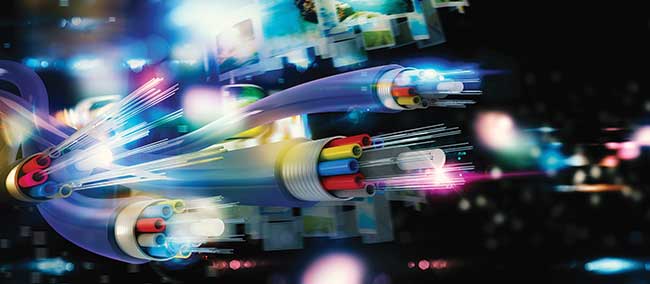Ultralow-loss, large effective area fiber and innovations in signal modulations are helping increase bandwidth and cut costs of transmitting data.
 The rising amount of data generated by people and machines around the world travels largely by fiber, with some of it moving thousands of miles in a hop. For some long jumps, new ultralow-loss, large effective area fiber is going into the ground and under the sea, leading to higher performance. There also are new signaling modulations and other innovations, all aimed at boosting bandwidth and cutting the cost of moving data.
But upping transmission power, which leads to a longer reach, or faster speeds in other situations, is not an option when it comes to fiber, according to Sergejs Makovejs, market and technology development manager at Corning Inc. of Corning, N.Y.
For every type of fiber, there is a power level that gives the best results.
“If you keep increasing the light power further, your performance will go down,” Makovejs said.
This is because fiber is a nonlinear medium, which means brighter lasers can lead to crosstalk between channels and other performance degrading effects. Thus, there is a fiber-dependent optimum light power point, a level at which performance is maximized. Transceivers and other system components are typically set at this point, Makovejs said.
What does work to increase bandwidth and cut costs is ultralow-loss, large effective area fiber, which has long been used in submarine applications, according to Makovejs. Such fibers have special manufacturing techniques and materials such as a pure silica core instead of a germania-doped one. These improvements drop attenuation from 0.2 dB/km to less than 0.17 dB/km, which translates to a 3-dB gain in system performance per 100 km of fiber. The 0.17 dB/km attenuation level is the threshold for the ultralow-loss fiber designation, per industry convention.
Such improvements are important when data rates rise. Corning calculations show that going from 100-Gbps transmission rates, the current state-of-the-art, to the soon-to-be standard 200 Gbps can drop the signal reach from a few thousand kilometers to several hundred for a fiber with typical loss characteristics. With ultralow-loss, large effective area fiber, the point at which signal regeneration is needed can be significantly extended.
That is beneficial because there is a trend for signal regeneration sites to be eliminated. One example of this can be found in submarine cables, which in the past terminated on the shore with the data then moved to a data center. Thus, there were two regeneration points: one on the shore and another in the data center. Now, new submarine cables are more often terminating in a data center itself, thereby cutting the regeneration points in half and producing cost savings.
“In an optical fiber, you typically have approximately 100 wavelength division multiplexed channels. With regeneration, you would have to regenerate every single wavelength, and that becomes very, very expensive,” Makovejs said.
The rising amount of data generated by people and machines around the world travels largely by fiber, with some of it moving thousands of miles in a hop. For some long jumps, new ultralow-loss, large effective area fiber is going into the ground and under the sea, leading to higher performance. There also are new signaling modulations and other innovations, all aimed at boosting bandwidth and cutting the cost of moving data.
But upping transmission power, which leads to a longer reach, or faster speeds in other situations, is not an option when it comes to fiber, according to Sergejs Makovejs, market and technology development manager at Corning Inc. of Corning, N.Y.
For every type of fiber, there is a power level that gives the best results.
“If you keep increasing the light power further, your performance will go down,” Makovejs said.
This is because fiber is a nonlinear medium, which means brighter lasers can lead to crosstalk between channels and other performance degrading effects. Thus, there is a fiber-dependent optimum light power point, a level at which performance is maximized. Transceivers and other system components are typically set at this point, Makovejs said.
What does work to increase bandwidth and cut costs is ultralow-loss, large effective area fiber, which has long been used in submarine applications, according to Makovejs. Such fibers have special manufacturing techniques and materials such as a pure silica core instead of a germania-doped one. These improvements drop attenuation from 0.2 dB/km to less than 0.17 dB/km, which translates to a 3-dB gain in system performance per 100 km of fiber. The 0.17 dB/km attenuation level is the threshold for the ultralow-loss fiber designation, per industry convention.
Such improvements are important when data rates rise. Corning calculations show that going from 100-Gbps transmission rates, the current state-of-the-art, to the soon-to-be standard 200 Gbps can drop the signal reach from a few thousand kilometers to several hundred for a fiber with typical loss characteristics. With ultralow-loss, large effective area fiber, the point at which signal regeneration is needed can be significantly extended.
That is beneficial because there is a trend for signal regeneration sites to be eliminated. One example of this can be found in submarine cables, which in the past terminated on the shore with the data then moved to a data center. Thus, there were two regeneration points: one on the shore and another in the data center. Now, new submarine cables are more often terminating in a data center itself, thereby cutting the regeneration points in half and producing cost savings.
“In an optical fiber, you typically have approximately 100 wavelength division multiplexed channels. With regeneration, you would have to regenerate every single wavelength, and that becomes very, very expensive,” Makovejs said.
Member Exclusive: To read the complete article, please Login or Register